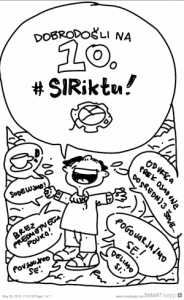Katarina Perič, Osnovna šola Staneta Žagarja Lipnica, Kropa
The article discusses the case of Slovenian language classes at a distance learning in small groups. These are mostly individual classes following the established practice using either Skype or Moodle. It is an example of learning the slovene language outside the traditional classroom, with the help of information and communication technology, which helps to bridge distances and time zones between teachers and students around the world. Slovene at a distance learning includes the children of parents with Slovenian roots that live abroad. Due to the huge distance of their place of residence they are unable to attend any of the groups taughtby the Slovene native speakers. These students therefore have no possibility experiencing learning the Slovenian language in a group of peers. This is exactly what we want them to enable with these classes. We have created their meeting space with the help of modern technology. We formed a small learning group students according to their age, level of knowledge of the Slovenian language and according to the time zone of residence. In the online classroom students can find the pre-prepared materials and activities. Part of the classes were then carried out through skype conference. Some of the activities were done after the conference, students posted their works to to online classroom and later on they received the feedback. The presented form of teaching Slovene at a distance learning allows a greater interaction between peers involved in the program. It is an opportunity to learn and connect, share their experiences, perhaps looking for the amenities of integration and weaving new friendships. Such lessons enable to work in pairs, groups, collaborative work between students and become more like lessons in classical classroom. This way of teaching has proved to be a highty motivating factor for learning the slovene language. The method also enables to prepare further tasks using the learned knowledge including its evaluating and testing. One of the main obstacles of grouping students in to smaller groups is certainly time difference due to the large distances between their places of residence. Technical obstacles can also be a problem especially the ones we cannot predict such as noise, poor internet connection, programms not working properly etc.). Consequently the classes sometimes last longer than planned. Of course, a student wanting to participate this form of learning must be skilled to use ICT independently.
